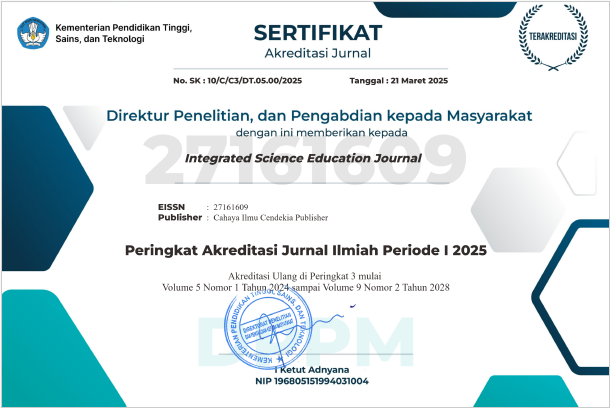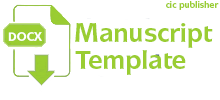Advancing Sustainable Development Goal 6: Innovations, Challenges, and Pathways for Clean Water and Sanitation
Abstract
Purpose of the study: The aim of this research is to analyze the global state of clean water and sanitation, identify the main challenges faced, and explore innovative solutions and strategies that can contribute to the achievement of Sustainable Development Goal 6 by 2030.
Methodology: This study employed a systematic literature review and comparative analysis with secondary data from WHO, UNICEF, and the World Bank. Data collection was conducted through international databases such as Scopus, Web of Science, and Google Scholar. Data analysis was conducted using descriptive quantitative analysis and thematic qualitative analysis using a matrix-based instrument.
Main Findings: Research shows that more than 2.2 billion people still lack access to safe drinking water and 3.4 billion people lack adequate sanitation services, with the greatest disparities occurring in Sub-Saharan Africa and South Asia. Innovations such as smart water monitoring, low-cost filtration, rainwater harvesting, and community-based sanitation programs have proven to have significant impact. However, persistent barriers include limited funding, social inequality, climate change, and weak governance.
Novelty/Originality of this study: This research integrates technological innovation, public health approaches, community participation, and policy frameworks into a comprehensive analysis of clean water and sanitation. Unlike previous research that focused solely on technical or health aspects, this study expands knowledge by mapping multidimensional strategies and providing practical recommendations for policymakers and stakeholders.
References
A. N. Angelakis et al., “Water quality and life expectancy: Parallel courses in time,” Water, vol. 13, no. 752, pp. 1–15, 2021.
L. Anatolia S.M. Exposto, M. Nahak Lino, J. A.C. Quim, M. Juvi Goncalves, and H. Pereira Vicente, “Efforts to improve clean water quality to support community health,” KESANS Int. J. Heal. Sci., vol. 1, no. 3, pp. 236–251, 2021, doi: 10.54543/kesans.v1i3.24.
P. Bazaanah and R. A. Mothapo, Sustainability of drinking water and sanitation delivery systems in rural communities of the Lepelle Nkumpi Local Municipality, South Africa, vol. 26, no. 6. Springer Netherlands, 2024. doi: 10.1007/s10668-023-03190-4.
G. M. Shayo, E. Elimbinzi, G. N. Shao, and C. Fabian, “Severity of waterborne diseases in developing countries and the effectiveness of ceramic filters for improving water quality,” Bull. Natl. Res. Cent., vol. 47, no. 1, pp. 1–14, 2023, doi: 10.1186/s42269-023-01088-9.
J. H. Ellwanger, A. Beatriz, V. D. L. Kaminski, and J. María, “Control and prevention of infectious diseases from a One Health perspective,” Genet. Mol. Biol., vol. 44, no. suppl 1, pp. 1–23, 2021.
R. A. Kristanti, T. Hadibarata, M. Syafrudin, M. Yılmaz, and S. Abdullah, “Microbiological contaminants in drinking water: Current status and challenges,” 2022, Springer International Publishing. doi: 10.1007/s11270-022-05698-3.
E. U. Alum, E. I. Obeagu, and O. P. C. Ugwu, “Enhancing quality water, good sanitation, and proper hygiene is the panacea to diarrhea control and the attainment of some related sustainable development goals A review,” Med. (United States), vol. 103, no. 38, p. e39578, 2024, doi: 10.1097/MD.0000000000039578.
R. Suleiman, N. R. G. Danga, and A. Mustapha, “Enhancing environmental sanitation education and capacity building for sustainable development in a depressed economy,” Int. J. Hum. Kinet. Heal. Educ., vol. 9, no. 2, pp. 110–118, 2024.
A. Shrestha et al., “Water, sanitation, and hygiene of nepal: status, challenges, and opportunities,” ACS ES&T Water, vol. 3, no. 6, pp. 1429–1453, Jun. 2023, doi: 10.1021/acsestwater.2c00303.
D. Adugna, “Challenges of sanitation in developing counties - Evidenced from a study of fourteen towns, Ethiopia,” Heliyon, vol. 9, no. 1, p. e12932, 2023, doi: 10.1016/j.heliyon.2023.e12932.
O. J. Okesanya et al., “Water, sanitation, and hygiene (WASH) practices in Africa: exploring the effects on public health and sustainable development plans,” 2024, BioMed Central. doi: 10.1186/s41182-024-00614-3.
H. Aman, Z. H. Doost, A. W. Hejran, A. D. Mehr, R. Szczepanek, and G. Gilja, “Survey on the challenges for achieving SDG 6 Clean water and sanitation: A global insight,” Knowledge-Based Eng. Sci., vol. 5, no. 3, pp. 21–42, 2024, doi: 10.51526/kbes.2024.5.3.21-42.
C. T. Okoji, O. T. Arowolo, M. C. Okoji, and A. U. Owolabi, “Knowledge and attitude ofoffa residents on clean water and sanitation (SDG Six),” Au J. Bus. Soc. Sci., vol. 5, no. 1, pp. 269–281, 2025.
G. Mujtaba, M. U. H. Shah, A. Hai, M. Daud, and M. Hayat, “A holistic approach to embracing the United Nation’s Sustainable Development Goal (SDG-6) towards water security in Pakistan,” J. Water Process Eng., vol. 57, no. November 2023, pp. 1–18, 2024, doi: 10.1016/j.jwpe.2023.104691.
S. Biswas, M. Adhikary, A. Alam, N. Islam, and R. Roy, “Disparities in access to water, sanitation, and hygiene (WASH) services and the status of SDG-6 implementation across districts and states in India,” Heliyon, vol. 10, no. 18, pp. 1–17, 2024, doi: 10.1016/j.heliyon.2024.e37646.
M. S. Javed, U. Nisar, V. S. R. G, S. H. Warsi, M. M. Billah, and E. A. Karkkulainen, “Mapping the disparities between urban and rural areas in the global attainment of sustainable development goals, economic and social aspects of global rural-urban migration,” Educ. Adm. Theory Pract., vol. 30, no. 6, pp. 2065–2076, 2024, doi: 10.53555/kuey.v30i6.5650.
H. K. Fotio and S. M. Nguea, “Access to water and sanitation in Africa: Does globalization matter?,” Int. Econ., vol. 170, no. March, pp. 79–91, 2022, doi: 10.1016/j.inteco.2022.02.005.
R. I. Dip, Z. M. M. Hossain, A. Hossain, and I. Haque, “Domestic water filtration technologies in Bangladesh: Challenges, innovations and socio-cultural dimensions,” Barind Med. Coll. J., vol. 11, no. 1, pp. 93–99, 2025, doi: 10.70818/bmcj.2025.v011i01.0165.
M. F. Prescott, M. F. Dobbie, and D. Ramirez-Lovering, “Green infrastructure for sanitation in settlements in the global south: A narrative review of socio-technical systems,” Sustain., vol. 13, no. 4, pp. 1–20, 2021, doi: 10.3390/su13042071.
T. Yasmin, S. Dhesi, I. Kuznetsova, R. Cooper, S. Krause, and I. Lynch, “A system approach to water, sanitation, and hygiene resilience and sustainability in refugee communities,” Int. J. Water Resour. Dev., vol. 39, no. 5, pp. 691–723, 2023, doi: 10.1080/07900627.2022.2131362.
N. E. Clarke, C. E. F. Dyer, S. Amaral, G. Tan, and S. V. Nery, “Improving uptake and sustainability of sanitation interventions in timor-leste: A case study,” Int. J. Environ. Res. Public Health, vol. 18, no. 3, pp. 1–13, 2021, doi: 10.3390/ijerph18031013.
N. P. Aryani and B. R. Afrida, “The relationship between environmental sanitation and stunting incidence,” J. Ilm. STIKES Yars. Mataram, vol. 15, no. 2, pp. 137–145, 2025.
W. Anwar, N. Nurjazuli, and T. Joko, “The relationship household environmental sanitation with incidence of stunting in toddlers: Literature review,” Indones. J. Heal. Promot., vol. 7, no. 10, pp. 2422–2429, 2024.
R. Bain, R. Johnston, F. Mitis, C. Chatterley, and T. Slaymaker, “Establishing sustainable development goal baselines for household drinking water, sanitation and hygiene services,” Water (Switzerland), vol. 10, no. 12, pp. 1–19, 2018, doi: 10.3390/w10121711.
K. Setty, A. Jiménez, J. Willetts, M. Leifels, and J. Bartram, “Global water, sanitation and hygiene research priorities and learning challenges under sustainable development goal 6,” Dev Policy Rev, vol. 38, no. 1, pp. 64–84, 2020, doi: 10.1111/dpr.12475.Global.
A. T. Aborode et al., “Impact of climate change-induced flooding water related diseases and malnutrition in Borno State, Nigeria: A public health crisis,” Environ. Health Insights, vol. 19, pp. 1–11, 2025, doi: 10.1177/11786302251321683.
R. K. Mishra, “Fresh water availability and it’s global challenge,” J. Mar. Sci. Res., vol. 2, no. 1, pp. 01–03, 2023, doi: 10.58489/2836-5933/004.
R. El-Bouayady and H. Radoine, “Urbanization and sustainable urban infrastructure development in Africa,” Environ. Ecol. Res., vol. 11, no. 2, pp. 385–391, 2023, doi: 10.13189/eer.2023.110212.
M. A. Rahaman, A. Kalam, and M. Al-Mamun, “Unplanned urbanization and health risks of Dhaka City in Bangladesh: uncovering the associations between urban environment and public health,” Front. Public Heal., vol. 11, pp. 1–18, 2023, doi: 10.3389/fpubh.2023.1269362.
H. I. Cheong, A. Lyons, R. Houghton, and A. Majumdar, “Secondary qualitative research methodology using online data within the context of social sciences,” Int. J. Qual. Methods, vol. 22, pp. 1–19, 2023, doi: 10.1177/16094069231180160.
T. K. Haynes-Brown and M. D. Fetters, “Using joint display as an analytic process: An illustration using bar graphs joint displays from a mixed methods study of how beliefs shape secondary school teachers’ use of technology,” Int. J. Qual. Methods, vol. 20, pp. 1–14, 2021, doi: 10.1177/1609406921993286.
T. Justesen, J. Freyberg, and A. N. Ø. Schultz, “Database selection and data gathering methods in systematic reviews of qualitative research regarding diabetes mellitus-an explorative study,” BMC Med. Res. Methodol., vol. 21, no. 1, pp. 1–12, 2021, doi: 10.1186/s12874-021-01281-2.
S. Almasi, K. Bahaadinbeigy, H. Ahmadi, S. Sohrabei, and R. Rabiei, “Usability evaluation of dashboards: A systematic literature review of tools,” Biomed Res. Int., vol. 2023, 2023, doi: 10.1155/2023/9990933.
D. Baye, “Sustainable development goals (SDG) target 6.2 in Ethiopia: Challenges and opportunities,” Open Access Libr. J., vol. 08, no. 05, pp. 1–28, 2021, doi: 10.4236/oalib.1107458.
WHO and UNICEF, “1 in 4 people globally still lack access to safe drinking water – WHO/UNICEF Joint Monitoring Programme (JMP) report,” UNICEF. [Online]. Available: https://www.unicef.org/press-releases/fast-facts-1-4-people-globally-still-lack-access-safe-drinking-water-who-unicef
W. H. Organization, “1 in 4 people globally still lack access to safe drinking water,” WHO. [Online]. Available: https://www.who.int/philippines/news/detail-global/26-08-2025-1-in-4-people-globally-still-lack-access-to-safe-drinking-water---who--unicef?
U. Nations, “Ensure availability and sustainable management of water and sanitation for all (SDG 6).” [Online]. Available: https://unstats.un.org/sdgs/report/2025/Goal-06/
L. Demoze et al., “Determinants and geographic distribution of unimproved sanitation facilities in sub-Saharan Africa, spatial and multilevel analysis using demographic and health survey (DHS) data,” BMC Public Health, vol. 25, no. 1, pp. 1–16, 2025, doi: 10.1186/s12889-025-24184-z.
G. Ssekyanzi, M. J. Ahmad, and K. S. Choi, “Sustainable solutions for mitigating water scarcity in developing countries: A comprehensive review of innovative rainwater storage systems,” Water (Switzerland), vol. 16, no. 17, pp. 1–21, 2024, doi: 10.3390/w16172394.
Z. H. Doost, M. Alsuwaiyan, and Z. M. Yaseen, “Runoff management based water harvesting for better water resources sustainability: A comprehensive review,” Knowledge-Based Eng. Sci., vol. 5, no. 1, pp. 1–45, 2024, doi: 10.51526/kbes.2024.5.1.1-45.
T. T. Praja, D. W. S. Rengganis, D. A. Iryani, and L. Hakim, “Evaluation of community participation in community- based water supply and sanitation programs in Kampung Rantau Jaya Ilir, Central Lampung Regency,” Int. J. Islam. Educ. Res. Multiclturalism, vol. 5, no. 3, pp. 673–690, 2023.
A. Mustika and I. Kustiani, “Community participation and management performance on the quality of service provision of community-based drinking water and sanitation facilities in Kelawi …,” Lampung Int. J. …, vol. 1, no. 1, pp. 22–27, 2022, [Online]. Available: http://lije.eng.unila.ac.id/index.php/ojs/article/view/5
G. Howard et al., “The how tough is WASH framework for assessing the climate resilience of water and sanitation,” npj Clean Water, vol. 4, no. 1, pp. 1–10, 2021, doi: 10.1038/s41545-021-00130-5.
A. Wriege-Bechtold, M. Barjenbruch, C. Sieker, A. Peter-Fröhlich, B. Heinzmann, and B. Lengemann, “Production of energy by co-fermentation with contents from fat separators,” J. Water Clim. Chang., vol. 1, no. 4, pp. 251–257, 2010, doi: 10.2166/wcc.2010.105.
M. Falkenmark and J. Rockström, “Building water resilience in the face of global change: From a blue-only to a green-blue water approach to land-water management,” J. Water Resour. Plan. Manag., vol. 136, no. 6, pp. 606–610, 2010, doi: 10.1061/(asce)wr.1943-5452.0000118.
D. Butler et al., “Reliable, resilient and sustainable water management: The Safe & SuRe approach,” Glob. Challenges, vol. 1, no. 1, pp. 63–77, 2017, doi: 10.1002/gch2.1010.
S. Nelson, D. Drabarek, A. Jenkins, J. Negin, and S. Abimbola, “How community participation in water and sanitation interventions impacts human health, WASH infrastructure and service longevity in low-income and middle-income countries: A realist review,” BMJ Open, vol. 11, no. 12, pp. 1–18, 2021, doi: 10.1136/bmjopen-2021-053320.
F. R. Nasution and C. Nuraini, “Study on the preparation of regional policy and strategy for drinking water supply system (JAKSTRADA SPAM) Batu Bara Regency,” Int. Conferance Digit. Sci. Eng. Technol. , vol. 1, no. 1, pp. 229–239, 2024, [Online]. Available: https://proceeding.pancabudi.ac.id/index.php/ICDSET/article/view/181
M. Egerer et al., “Urban change as an untapped opportunity for climate adaptation,” npj Urban Sustain., vol. 1, no. 1, pp. 1–9, 2021, doi: 10.1038/s42949-021-00024-y.
X. Yuan et al., “Impacts of global climate change on agricultural production: A comprehensive review,” Agronomy, vol. 14, no. 7, pp. 1–19, 2024, doi: 10.3390/agronomy14071360.
Copyright (c) 2025 Msafiri Mmamba Jackson, Amjd Abdallah Omer Alfaki

This work is licensed under a Creative Commons Attribution 4.0 International License.
Authors who publish with this journal agree to the following terms:
- Authors retain copyright and acknowledge that the Integrated Science Education Journal is the first publisher licensed under a Creative Commons Attribution 4.0 International License.
- Authors are able to enter into separate, additional contractual arrangements for the non-exclusive distribution of the journal's published version of the work (e.g., post it to an institutional repository or publish it in a book), with an acknowledgment of its initial publication in this journal.
- Authors are permitted and encouraged to post their work online (e.g., in institutional repositories or on their website) prior to and during the submission process, as it can lead to productive exchanges and earlier and greater citation of published work.







.png)
.png)






